ISSN: 2977-814X
ISSUE DOI: https://doi.org/10.51596/sijocp.v4i1 Volume 4 Issue 1
journal.spacestudies.co.uk
Sina Zarei Hajiabadi, Chair of Architectural History and Curatorial Practice, Technical University of Munich, Germany
https://orcid.org/0009-0009-4789-1131
![]()
Received September 15, 2023
Accepted December 10, 2023
Published Online March 30, 2024
https://doi.org/10.51596/sijocp.v4i1.6
![]()
Abstract
This paper examines the evolution of Iranian architectural magazines, focusing on discernible shifts in the involvement and portrayal of women during three distinct periods spanning from 1946 to 2001. From 1946 to 1969, female contributions to the magazines were markedly scarce initially, with depictions limited to non-progressive representations of women in traditional roles and endorsements directed towards the Queen. Along with the modern cultural initiatives of the Pahlavi state in the 1970s, the magazines transitioned from a prior disregard for female figures to occasionally recognising them as equally capable professionals. In contrast to this shift and the gradual growth in the number of educated and professional women before and after the 1979 revolution, the Islamic Republic embarked on a systematic effort to marginalise women and censor their images from public view. Challenging the post-revolutionary moments of limitation and censorship, few charismatic figures succeeded in redefining their roles and images in architectural magazines, especially after the revivals of 1991 and 1998 that were marked by the publication of two ground-breaking magazines. This study, supported by a comprehensive historical review, employs Theo van Leeuwen’s discourse analysis, revealing the intricate interplay of four discursive strategies in shaping women’s representation in Iranian architectural magazines across the three periods. The text underscores the impact of pre- and post-revolutionary societal and political changes. It highlights how the resilience of Iranian women led to an unprecedented redefinition of female professional roles in the 1990s.
Keywords: architectural magazines, Iran, women, representation, discourse
![]()
Introduction
Since the 1960s, architectural magazines have played a crucial role in enriching the sources of architectural history, serving as significant historical documents that historians have used to explore new perspectives in the field. Initially, the research focus centred on content analysis, employing a theoretically neutral reading of the texts within periodicals (Vanlaethem & Jannière, 2008). However, by the late 1970s and 1980s, a shift occurred as architectural historians began adopting critical perspectives, viewing these publications as active social institutions (Lipstadt, 1982) within the architectural profession and society at large (Parnell, 2011). Lipstadt, particularly, challenged a naive reading that assumed the transparency of discourse and urged recognition
of potential biases and complexity. This criticism of simplistic understandings emphasised the necessity of structuring research in the field of solid social theories.
This paper builds upon this critical tradition to examine how Iranian architectural magazines, functioning as private or state-based institutions in society, have shaped diverse images of women, impacting broader societal perceptions of them in Iran since 1946. Recognising Iranian architectural magazines as “battlegrounds of meaning” (Parnell, 2011, p. xii), the present paper aims to reveal how these magazines have influenced architectural discourse and, in turn, either advanced or hindered women’s status within society. The paper employs van Leeuwen’s discursive strategies framework to achieve this, uncovering the intricate connections between seemingly straightforward texts and visuals in professional publications and traditional beliefs, political choices, and social movements.
The scarcity of critical examinations of Iranian architectural magazines necessitates a thorough analysis of the visual and textual representations of women in these publications. While Mirzaei’s “The Idea of Architecture” (Mirzaei, 2016) deserves recognition for emphasising the significance of textual content and offering a meticulous content analysis of pre-1979 magazines, Pishvaei et al.’s research (2020) also provides a comprehensive analysis of the primary categories of discussions in both pre and post-revolutionary magazines. Building on this foundation, this paper extends the perspective by incorporating a slightly broader historical context, exploring how these magazines have contributed to the development of portrayals of women over time. The paper will reveal how these publications have reflected and shaped societal attitudes towards women by analysing the visual and textual representations of women in Iranian architectural magazines. This analysis will provide insights into the complex relationship between architecture, gender, and society in Iran. It will contribute to a broader understanding of the role of architecture in shaping societal norms and values.
Cautious Steps in the Shadows of Tradition (1946-1969)
Pioneering Women and Architectural Inertia (1906-1948)
While Iranian educated women championed gender equality through magazines during the 1906 Constitutional Revolution (Sanasarian, 1982; Shahidi, 2002, p.71), professions like architecture remained relatively detached from modern developments. This disconnect stemmed from the persistent gulf between traditional Iranian architecture and textual production (Qayyoomi, 2009), one of the critical factors that delayed the integration of Iranian architecture into the modern era. Even during Reza Shah’s reign (1925-1940), characterised by his ambitious modernisation initiatives, state-sponsored magazines confined architectural discourse to the borders of nationalism, emphasising the distinctiveness of Persian art (Zarei, 2015). Nevertheless, the inauguration of the Faculty of Fine Arts in 1940 introduced a modern educational program, effectively bridging the gap between traditional architectural practices and the modern realm of text production (Grigor, 2005).
A decade of expanding social liberties commenced in Iran following Reza Shah’s succession by his son, Mohammadreza, in 1940. Driven by a commitment to modern social education, the newly established Communist Party (Tudeh) collaborated with feminist activists and modern- educated architects to form two prominent associations: the Association of Iranian Diplom Architects (A.I.D.A) and the Organization of Iranian Women. (Khosravi, 2019)
In 1946, the establishment of Architecte magazine by the Association of Iranian Diplom Architects (A.I.D.A.) marked a significant milestone in the emergence of a modern identity for the burgeoning generation of Iranian architects (Grigor, 2005). However, while the magazine of the Organisation of Iranian Women (Bidari-e Ma) vigorously championed women’s rights with its slogan “We have a right in this home,” demanding transformative changes in their societal standing (Shahidian, 1994, p.224), Architect largely overlooked the social changes of the country.
From 1946 to 1948, Architecte’s pages overwhelmingly presented men as charismatic architects, showcasing their involvement in architectural design or construction work (Figure 1.). In contrast, women were relegated to decorative roles reminiscent of traditional miniature paintings and depicted as engaged in household chores (Figure 2.). Despite the noteworthy increase in female
enrolment in secondary education during the early 1940s (Menashri, 1992) and their pioneering involvement in academic architectural education (Rasooli, 2018), they remained virtually absent from the burgeoning architectural discourse and were essentially marginalised in Architecture.


Figure 1 (left). Architect Vartan Avanesian’s Portrait. Source: Architecte 1, 1946 – p.32.
Figure 2 (right). Image of a Modern Women in Architecte. Source: Architect 6, 1948 – p.205.
The Throne, the Ad, and the Talented (1955-1969)
The 1953 CIA-backed coup marked the end of a decade characterised by increased social freedom and facilitated Mohammadreza Shah’s expansion of his political authority. Throughout the 1950s, he consolidated his influence across intellectual spheres, mirroring the authoritarian legacy of his father (Abrahamian, 2008). The emergence of the second Iranian architectural magazine, Bank-e Sakhtemani (Building Bank), supported by a state-based organisation of the same name, was a direct consequence of this political climate.
Alongside the organisation’s involvement in the state’s housing plans, the magazine embarked on its journey in 1955, dramatically showcasing a full-page image of the Shah and the Queen on the opening page (Figure 3.). Despite the Shah’s dominant patriarchal presence, the image represented a nascent attempt to transcend traditional norms, depicting the female member of the Royal Family as a partner in the development plans. However, in both magazine series (1955- 1958) and (1961-1963), only two instances featured non-royal women portrayed in headscarves and family settings, devoid of identifiable features. Concurrently, the second volume of Bank consistently invoked Iranian cultural desires and architectural traditions to legitimise the practice of concealing women for the sake of their protection:
“Iranians, both before and after embracing the religion of Islam […] have shown a preference for concealing their women and sanctuaries from the gaze of outsiders. To minimize contact between women and outsiders, they desired a separate space for them within the house. They even incorporated baths within their homes so that their sanctuaries didn’t require them to venture outside for bathing.” (Bank-e Sakhtemani 1(2), 1957, p.7)
During the 1960s, traditional views on women’s roles were increasingly challenged by intellectual resistance movements, the state’s efforts to enhance women’s political participation, and a
significant decline in female illiteracy rates (Mitch, 2019). Amidst this evolving landscape, two new architectural magazines emerged in Iran: Memari-e Novin (Modern Architecture) and Abadani- va Maskan (Prosperity and Housing). Under the supervision of Architect Vartan, Memari-e Novin launched in 1961 and published its second volume in March 1962, acknowledging the pioneering work of Nectar Papazian-Andreef, Iran’s first female architect (Rasooli, 2018). Between 1962 and 1965, Memari-e Novin (Modern Architecture) incorporated the work of six female artists, marking a small but significant step towards integrating professional women into the discourse of architecture. In contrast to the relatively progressive approach of the main body in featuring professional women, the advertising discourse of Memari-e Novin exhibited a regression in terms of gender equality. While men were portrayed with the seriousness of technical work, five out of the six repeating advertisements “saved women from seriousness of reality” (Goffman, 1979, p. viii), primarily by capturing them with child-like smiles and care-free the seriousness of reality” (Goffman, 1979, p. viii), primarily by of the six repeating advertisements “saved women from the seriousness of reality” (Goffman, 1979, p. viii), capturing them with child-like smiles and carefree faces. (Figure 4.).

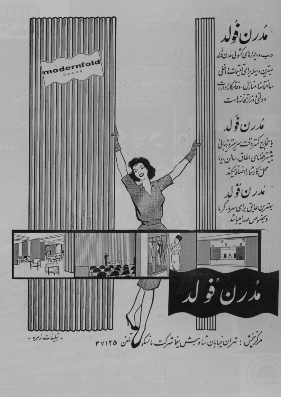
Figure 3 (left). Mohammadreza Shah and Queen Sorrayya. Source: Bank-e Sakhtemani 1(1), 1955 – p.2.
Figure 4 (right). A Woman in a Folding Door Advertisement. Source: Memari Novin 2, 1961 – p.17.
After the untimely demise of Bank-e Sakhtemani (Mirzaei, 2016) and the financial downfall of Memari-e Novin, the government once again stepped in to fill the void in the discourse of architecture, this time by launching a magazine under the auspices of the Ministry of Abadani-va Maskan (Prosperity and Housing). The magazine Abadani-va Maskan commenced its publication in October 1961. In the following February, it featured Queen Farah Diba in a striking full-page portrait titled “A Great Lady with a Great Dream” (Figure 5).
Following this notable portrayal, the Queen garnered widespread acclaim for her unwavering commitment to urban development and her astute leadership of the Supreme Council of Urban Planning. In contrast, non-royal female figures remained surprisingly absent from the magazine’s pages, with only two notable exceptions on the pages of Abadani-va Maskan. From 1966 to 1967, the magazine welcomed the contributions of Golnar Raeis and Niloufar Bagherzadeh, who actively participated in cover design and authored articles on subjects such as interior decoration and the history of museums. Although their contributions may have appeared peripheral to
the magazine’s central focus, their portrayal served as a pivotal step towards enabling Iranian women to assume editorial roles in architectural publications, laying the foundation for future generations of Iranian women to pursue their architectural aspirations with greater confidence and recognition.

Figure 5. A Portrait of Queen Farah. Source: Abadani-va-Maskan 2, 1966 – p.5.
From the Authority of Tradition to the Emergence of a Royal Role Model
From 1946 to 1969, architectural magazines largely disregarded the growing movement for women’s equal rights. Instead, they occasionally resorted to the “authority of tradition” as the primary discursive strategy to legitimise conservative portrayals of women. Traditional values played a crucial role in shaping the accepted roles of women within the family setting, and magazines like Architecte utilised this notion to firmly associate women with domestic spaces like kitchens and chores related to homemaking. As van Leeuwen (2008) aptly observes, the authority of tradition is not unthinkingly followed but rather stems from the notion that it has always been the established norm. (van Leeuwen, 2008, p. 108). Bank-e Sakhtemani, echoing this approach, drew upon Iranian traditional architecture as a powerful source of authority to justify the confinement and protection of women behind the walls of traditional architecture.
Taking a different approach, Memari-e Novin’s advertisements captured women in European features, juxtaposed them against modern technological elements, and placed them within modern interior settings. The “Analogy” discursive strategy was employed within this context to conjure a modern dream reminiscent of Western ideals. However, this same strategy served to mask the deeply ingrained traditional values, perpetuating non-progressive representations of women. While women in Memari-e Novin were portrayed as significant individuals, they were also confined to a passive role, with unserious expressions and almost exclusively depicted within interior spaces.
Alongside this intricate interplay between traditional gender norms and modern-looking bodies and faces, another parallel effort emerged to craft a royal role model in art and architecture. Simultaneously showering exaggerated accolades upon Queen Soraya and Queen Farah, Bank-e Sakhtemani and Abadani va Maskan encouraged women to follow the royal path, break free from their traditional confines, and venture into the professional realm. In the following sections, we will explore how the “Authority of Role Model” gained traction in the late 1960s and 1970s
magazines, eclipsing other discursive approaches and catalysing the ascent of the Women’s Question in the Iranian architectural landscape.
Unveiling Potentials: Women in HVM (1976-1979)
Dedicated to Her Majesty: Further Attempts for Creating a Royal Role Model
In February 1976, Abdolhamid Eshragh established the Association of Iranian Architects and launched its magazine, Honar-va-Memari (Art and Architecture), in the summer of 1969 (Dehbashi, 2002). Throughout its 48-volume run, 18 women engaged in nine distinct roles, contributing 28 editorial contributions. While their primary involvement focused on translation, Moira Moser Khalili assumed the co-editorship role in 1973, and four other women sporadically authored articles.
In parallel with the burgeoning contributions of female journalists and the groundbreaking inclusion of over 25 esteemed female experts in its pages, HvM steadfastly elevated Queen Farah as the pinnacle of role models, overshadowing all other female figures. The magazine extolled her profound understanding, highlighting her keen interest in the architectural arts (HvM 8, 1971), refined aesthetic sensibilities, and unwavering dedication to architectural issues (HvM 6-7, 1970).
On the pages of HvM, the Queen wielded significant influence over the direction of Iranian architecture: She had the power to shape architectural goals, reward competition winners, establish new institutions, and collaborate with the magazine and the association to elevate Iranian architecture to a new level of excellence. The magazine presented Queen Farah as a prominent art connoisseur, showcasing her cutting-edge modern art collection in its modern painting series featuring over 35 female faces and bodies (Figure 6.). This portrayal reinforced her image as a figure with impeccable taste in modern art, making her the ideal source for the magazine to curate a collection that would open the eyes of Iranians to modern art.


Figure 6 (left). Sylvette 21 by Pablo Picasso. Source: Honar-va-Memari 15-16, 1973 – p.143.
Figure 7 (right). Queen and The Children by F. Pilaram. Source: Honar-va-Memari 8, 1971 – p.3.
The 8th volume of HvM featured a painting titled “The Queen and the Children” (Figure 7.), depicting her as a benevolent mother figure embodying compassion and care for all Iranians. Adding a new level to all of her previous symbolic roles, at this moment, she also became the
subject of a painting that reinforced her symbolic representation as a compassionate and caring leader, aligning her with the traditional image of a nurturing mother figure. From a lecturer and expert to the symbolic model of a cultural leader, her multifaceted representation culminated in 1976 when she delivered the keynote address at the prestigious International Congress of Women Architects in Iran.
The International Congress of Women Architects, 1976
Volume 35-36 of HvM in 1976 was dedicated to the International Congress of Women Architects, held the following October in Ramsar. The magazine featured the Queen’s sketches and architectural drawings on the cover and the initial pages. It also included a report on the achievements and gender-related issues faced by American female architects (HvM 35-36, 1976). Additionally, it showcased a progressive illustration of female presence in architecture (Figure 8.). It published an article on “Women + Architecture,” which addressed women’s rights and advocated for gender equality in the field. Amid the Queen’s prominent presence in the magazine, there were sixteen articles profiling female architects with full-page portraits (Figure 9.), biographies, highlights of their successful architectural work, and, in some cases, interviews to gather their valuable insights.


Figure 8 (left). Woman + Architecture. Source: Honar-va-Memari 35-36, 1976 – p.14.
Figure 9 (right). Full-Page Portrait of the Architect Nooshin Ehssan. Source: Honar-va-Memari 35-36, 1976 – p.32.
In the opening of the Congress, themed “The Identity Crisis in Architecture,” the Queen paid tribute to the significant contributions of Iranian women towards the nation’s progress (The Crisis, 1977). During the sessions, Jane Drew expressed optimism about the ascendance of professional women in Iran (The Crisis, 1977, p.34), while Denis Scott Brown delved into the issue of gender discrimination within the American architectural profession (The Crisis, 1977, p.39-40). Gangneux’s contribution included an exploration of women’s liberation and feminist ideas (The Crisis, 1977, p.161), and Jean Young’s focus was on gender bias in the American architectural landscape (The Crisis, 1977, p.187). In contrast, the lectures failed to address the specific challenges faced by female architects in Iran. Instead, the speakers focused their presentations on broader theoretical and historical aspects of the architectural identity crisis.
The subsequent volumes of HvM also failed to maintain the same level of social consciousness and indicated that the magazine’s progressive approach was indeed a one-time occurrence. The last ten volumes, from 1976 to 1979, remained largely unchanged, perpetuating the objectification of women in advertising and the continued emphasis on Queen Farah as a role model. The lack of inclusivity towards women and the absence of efforts to achieve gender parity persisted throughout this period.
From the Advertising Smile to the Revolutionary Frown
Discourses shape symbolic role models by positioning them as experts, individuals of influence, or authoritative figures (van Leeuwen, 2007); in the case of HvM magazine, its most notable discursive move involved displacing the Authority of Tradition with endorsements of Queen Farah as the ultimate embodiment of modern art and architecture in Iran. Farah was presented as an all-encompassing role model, embodying expertise, a distinctive personality, and decision- making abilities, capable of excelling in diverse fields. Her symbolic significance was further amplified in HvM’s coverage of the Congress of Women Architects, where she was positioned as a testament to the professional capabilities of Iranian women, challenging the prevailing narrative of gender limitations.
Despite the magazine’s progressive stance in promoting female representation in its editorial content and its coverage of the Congress of Women Architects, gender bias persisted in HvM’s advertisements, often masked by their imitation of modern Western advertising styles. Out of the 23 recurring advertisements, a staggering 14 featured women portrayed as joyfully smiling in indoor settings, often associated with household chores or leisure activities (Figure 10.). These depictions perpetuated the traditional stereotype of women as primarily concerned with domesticity and personal adornment. In stark contrast, men were consistently depicted in more serious and active roles, emphasising their craftsmanship and professional competence (Figure 11.). However, there were a few exceptions to this pattern. Five alternative advertisements deviated from this gendered portrayal, featuring four women in active roles. These advertisements portrayed women as architects, artists, and professionals, challenging the traditional stereotypes and highlighting their potential for achievement (Figure 12.).
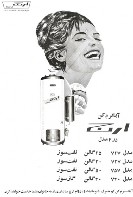
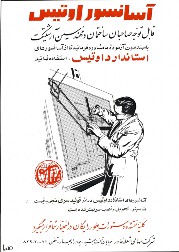
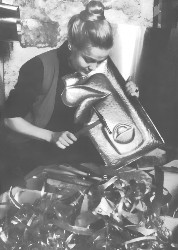
Figure 10 (left). The Feminine Lack of Seriousness in an Advertisement. Source: Honar-va-Memari 2, 1969
Figure 11 (middle). An Active Serious Man at Work. Source: Honar-va-Memari 10-11, 1971 – p.174.
Figure 12 (right). A Full-Page Portrait of a Female Artist. Source: Honar-va-Memari 27-28, 1975 – p.97.
Over a decade, HvM published ten images framing women as architects and artists, demonstrating their active participation in these fields. This limited but significant shift indicated the magazine’s recognition of the growing presence of women in modern professions and their contributions to society. A complex interplay of progressive and traditional elements marked HvM’s approach to gender representation. While the magazine made strides in promoting female role models and showcasing women in professional settings, it also struggled to break free from the pervasive
gender stereotypes in advertising fully.
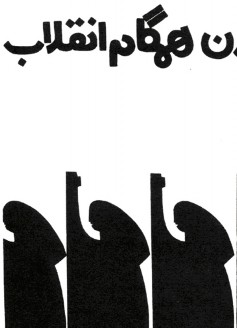
Figure 13. Woman along with The Revolution. Source: Honar-va-Memari 47-48, 1979 – p.10.
This fluctuation between active and passive depictions of women in HvM ceased with the publication of its final twin volume after the 1979 revolution. As a magazine affiliated with the Queen’s cultural plans, HvM had only one opportunity to continue publishing after the fall of the Royal Family in February 1979. In the last volume (47-48) following the revolution, both active and passive representations of women disappeared. The singular portrayal of women in that volume, titled “The Woman of the Revolution,” featured them draped in long black scarves, bearing arms in a rifle-like stance, symbolising their commitment to defending the revolution (Figure 13.). This imagery marked a symbolic shift from pre-revolutionary representations of women, heralding a new era for Iranian women and transforming the country’s landscape throughout the 1980s.
Scratched Faces: Women after 1979
Abadi: Rise of Female Architectural Journalists with Covered Faces (1991-1997)
The 1979 revolution ushered in a short period of freedom in political and journalistic activity (Axworthy, 2016, p. 141), contrasting the tight state censorship of the late pre-revolutionary years (Ghasemi, 2011). While the new era of freedom brought about new opportunities for social discourse, both “women’s issues” and “architecture” remained on the fringes of active social debates, failing to spark meaningful progressive discussions. The Islamic Republic’s consolidation of press control after Iraq’s invasion in 1980 further diminished the initial surge of freedom and the potential for these discussions to flourish. During this period, the few examples of architectural magazines, such as Jame’e va Memari (Society & Architecture), which attempted to open social discussions in the field, were increasingly influenced by radical political discourses, primarily criticising the imperialist-influenced aspects of Iranian architecture.
Gradually, to the end of the 1980s, female literacy rates in Iran exceeded 65% (Mitchell, 2019, p. 321), and an increase was observed in the participation of Iranian women in traditionally male- dominated fields such as architecture (Mehran, 2009, p. 553). However, the revolutionary forces systematically restricted open discussions on women’s rights throughout the decade and curtailed their public presence. Specifically, they introduced measures restricting female representations in both written and visual press. In contrast to the late Pahlavi Monarchy’s extensive portrayal of women in Westernized contexts, the dominant authorities of the early and mid-1980s ushered in a shift towards replacing such imagery with depictions of veiled women, children, and men,
even in those publications professionally focused on the issues of women (Figures 14-15). Given this, it was unsurprising that the few architectural publications were also wiped out of any female images and any reference to their issues.

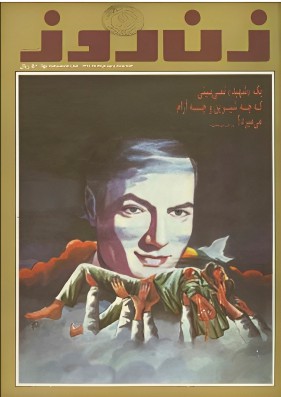
Figure 14 (left). The Cover of Zan-e Rooz (Woman of Today) Magazine [Four Months Before the Revolution]. Source: Zan-e Rooz 700, October 7th 1978,– p.cover.
Figure 15 (right). The Cover of Zan-e Rooz (Woman of Today) Magazine [After the Revolution]. Source: Zan-e Rooz 870, June 19th 1982,– p.cover.
Concurrent with the heavy wave of media control and imposed censorship, the Ministry of Housing and Urban Development established the Research Centre for Urban and Architectural Studies (RCUAS) to organise academic lectures, roundtables, seminars, curating exhibitions, and publishing technical books. Following the Iran-Iraq war’s end in 1988, increased financial support for “professional” publications spurred the RCUAS management board to envision an urban/ architectural magazine. Benefiting from an annual state-funded budget, the RCUAS launched the first volume of Abadi magazine in the summer of 1991, and it continued under the initial editorial board’s stewardship until the autumn of 1997.
From 1991-1997, Abadi depicted over 280 images portraying men as thinkers and expert architects, technicians and architectural award juries, whose ideas and decisions were deemed worthy of publication. Images that captured both male and female figures were limited to 23 instances, while only nine images framed women as individuals and women together were limited to 23 instances, while only nine images framed women as experts. Meanwhile, in the infrequent advertisements in Abadi, the occasional depictions of Iranian men as skilled and technically proficient individuals (Figure 16) signified a departure from this trend. This shift reflected the magazine’s endeavour to project a more masculine and less feminine image of the Iranian architectural landscape. In general, Abadi’s visual representation of women was conspicuously absent, with scant images depicting them primarily in group photographs (Figure 17) or from distant perspectives. This marginalisation of women’s presence extends beyond the magazine’s visual narrative and is sometimes discernible within the discourse of architecture itself:
“In houses, where they create what is commonly referred to as an open kitchen, they do not consider the fact that an Iranian woman should remain modestly hidden from the view of unrelated guests while working in the kitchen, and the bedroom and bathroom
should not be in the sight of guests.” (Abadi 2, 1991, p.4)
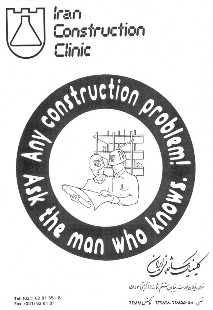
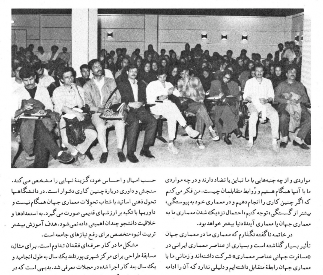
Figure 16 (left). The Man Who Knows. Source: Abadi 12, 1995 – p.101.
Figure 17 (right). Men and Women as The Listeners of a Lecture at The Research Centre. Source: Abadi 4, 1992 – p.17.
The limited visual representation of women in Abadi can be viewed as a continuation of the broader political censorship measures outlined earlier. In 1996, the Islamic Parliament of Iran formally institutionalised these informal practices into law, justifying the censorship of female imagery in the public media under the pretence of protecting and honouring women (Kaar, 2000, p. 141). In this challenging environment, where women’s involvement in architectural journals was constantly under threat, the persistent presence of three female individuals on the editorial staff proved crucial in maintaining their visibility and influence. Their consistent contributions as authors in almost every volume after 1992 served as a testament to their resilience and expertise, reinforcing their presence in the architectural discourse. Among these remarkable figures, Soheila Beski stood out for her exceptional contributions, particularly her instrumental role in establishing Memarnashr Publications and Memar Magazine in 1998.
Memar and the Emergence of a New Female Role Model (1998-2001)
In the wake of the 1997 presidential elections and the subsequent appointment of a new leadership in the Ministry of Housing and Urban Development, Abadi’s editorial board decided to depart from the state-supported system and establish a private magazine. (Hashemi, 2019). This initiative was spearheaded by Reza Hashemi, the former deputy minister for Architecture and Urban Design, and a charismatic female figure, Soheila Beski (Figure 18.), who had collaborated closely with Hashemi after transitioning her career from management and economics to urban and architectural journalism within the RCUAS. (Amirrahimi, 2022).
In the summer of 1998, after more than 13 years of working with the state-supported Research Centre (RCUAS) and Abadi magazine, Soheila Beski took the initiative to establish Memarnashr Publishing House in an old family house belonging to her father. Within the newly founded publishing house, she and Hashemi embarked on a groundbreaking endeavour by launching Memar magazine, assembling financial support from diverse stakeholders, including eight prominent female figures, forty-four male architects and designers, and eight private firms actively engaged in architectural and construction businesses.

Figure 18. Soheila Beski in a Memar Award Meeting. Source: Memar 98, 2016 – p.6.
With Soheila Beski at the helm, Memar magazine became a pioneer in empowering women in the architectural and urban planning fields. From its inception to the inaugural Memar Award ceremony in 2001, the magazine provided opportunities for thirty women, including graphic and layout designers, translators, editors, and authors. Women created twenty-one original articles and collectively managed the translation department, led by Farzaneh Taheri, the translation manager and one of the magazine’s core editors.
While Memar magazine recognised the contributions of over 80 female design professionals in the late 1990s and early 2000s, their roles largely centred around graphic design and supporting functions. Despite the growing recognition of female journalists and architects, only a handful stood out as prominent designers, competition winners, or individuals whose ideas were deemed worthy of publication. The stark gender imbalance within the Iranian architectural realm was more clearly shown in Memar’s visual representations. While male architects, designers, and thinkers dominated the magazine’s pages, appearing in over 90 instances, only two female architects were showcased, with their designs and portraits prominently displayed.
Amidst this unequal setting with limited avenues for freedom, Memar’s primary mission focused on a different goal, gradually contributing to forming a symbolic female figure. To justify the establishment of Iran’s first annual architecture award following the 1979 revolution (Memar Award), the magazine initiated a project of crafting essays that passionately advocated for the need for an architectural competition, emphasising its “necessity and a people’s demand” (Beski, 1998). Soheila Beski and other editorial board members authored a series of essays consistently featured in the first 14 volumes of Memar. This consistent publication propelled Soheila Beski, the upcoming Memar Award, and Memar magazine to be collectively recognised as a brand in architectural journalism, poised to select, introduce, and commend Iran’s finest architectural award. Following the inaugural Memar Award ceremony in the summer of 2001, during which several architects were honoured, the award swiftly emerged as a prominent institution in Iranian architecture. It garnered widespread trust and positioned Soheila Beski as the esteemed figurehead associated with its success.
A decade and a half later, just before the fourteenth Memar Award ceremony, Soheila Beski’s esteemed figure and symbolic image in Iranian modern architecture were again brought to light in a unique silent street ceremony organised by a group of award-winning architects. In the immediate aftermath of her passing in June 2015, several esteemed architectural firms paid homage to her memory, honouring her tenure as the manager of Iran’s premier architectural publication by draping white shawls (her emblematic attire) from their award-winning structures (Figure 19). Even though not overtly highlighted visually, Soheila Beski attained a symbolic status for women in Iranian architecture within a time characterised by the systematic censorship of
women’s representation (Figure 20).


Figure 19 (left). White Shawls Hanging from Award Winner Buildings [In The Momery of Soheila Beski].
Source: Memar 92, 2015
Figure 20 (right). The Cover of Memar Magazine in The Memory of Soheila Beski. Source: Memar 92, 2015 – p.cover.
Conclusion
The history of Iranian architectural magazines unveils the utilisation of four discursive strategies – reference to the authority of tradition, reference to the authority of a role model, analogy, and censorship – to construct and validate specific representations of women. The utilisation of these strategies shaped the representation of women in Iranian architectural discourse over time, reflecting the interplay of cultural, political, and social forces that have influenced women’s roles in Iranian society. While the analysis suggests that the representation of women has been marked by progress and regress, it also highlights the resilience of women in challenging and redefining these representations.
The first instances of resistance against the discursive strategies were spearheaded by the Pahlavi state, leading to an upsurge of female contributions to magazines and the acknowledgement of several female experts in journals and international events. However, a paradigm shift occurred following the revolution, necessitating the emergence of resilience among female experts. Due to the government’s abrupt transition to systematic censorship of women rather than selective representation, post-revolutionary female experts in architecture and journalism were compelled to forge a new path of resistance within the editorial boards of magazines.
Along with the growth in the number of educated and professional women after the revolution, the emergence of female role models like Beski was among the consequences of this shift. While censorship, systematic discrimination, and other societal and cultural factors continue to influence the representation of women in Iranian architectural magazines, and challenges remain in terms of equal representation and access to opportunities, such developments could indicate a shift towards a more inclusive and equitable narrative.
Conflict of Interests
No potential conflict of interest was reported by the author(s).
Biographical notes on authors
Sina Zarei Hajiabadi is a scholar with a master’s degree in the history of architecture. He is pursuing a PhD with a research focus on “The Meaning of Architecture in Persian Magazines of the 1990s. He has made notable academic contributions, including the upcoming book Descriptive Bibliography of Iranian Contemporary Architecture (awaiting publication in Iran), in which he co-authored and published a paper titled “Analysing Key Categories in the Literature of Contemporary Iranian Architecture.” Since October 2022, Sina has been supported by the Hanns Seidel Stiftung, a German institution dedicated to politically oriented research. Grounded in Discourse Theory, his research explores the intersection of architecture and text, aiming to uncover the discursive strategies that shape our understanding of architecture in the modern world.
Endnotes
This paper has been presented at the SPACE International Conference 2023 on Architectural Culture and Society.
References
Abadani va Maskan. (1966-1967). 1-4. The Ministry of Abadanai va Maskan. Tehran.
Abadi. (1991-1997). 1-23. The Research Center for Urban and Architectural Studies. Tehran. Abrahamian, E. (2008). A History of Modern Iran. Cambridge University Press.
Amirrahimi, R., personal interview, April 2022.
Architecte. (1946-1948). 1-6. The Association of Iranian Diplom Architects. Tehran.
Axworthy, M. (2016). Revolutionary Iran: A History of the Islamic Republic. Oxford University Press. Bank-e Sakhtemani. (1955-1958). 1(1-9). Bank-e Sakhtemani Association. Tehran.
Bank-e Sakhtemani. (1961-1962). 2(1-4). Bank-e Sakhtemani Association. Tehran. Bidari-e Ma. (1944). 1(1). The Democratic Organisation of Iranian Women. Tehran. Beski, S. (1998). Reviewing The Experience of Iran. Memar 1, 32-36.
Dehbashi, Ali. (2002, April-May). Interview with Engineer Eshragh. Bokhara, 23, 224-235.
Gharipour, M. (Ed.). (2019). Architectural Dynamics in Pre-Revolutionary Iran. Intellect Books Limited.
Ghasemi, F. (2011). Tarikh-e Matbouat-e Iran (The History of Iranian Press). Sanieh Publications. Goffman, E. (1979). Gender Advertisements. Harper Torchbooks.
Grigor, T. (2005). Cultivat(ing) Modernities: The Society for National Heritage, Political Propaganda, and Public Architecture in Twentieth-Century Iran [Doctoral dissertation]. DSpace@MIT.
Hashemi, R., personal interview, February 2019.
Honar va Memari. (1969-1979). 1-48. The Association of Iranian Architects. Tehran. Housing in Old Iran. (1957). Bank-e Sakhtemani, 1(2), 6-8.
Kaar, M. (2002). Mosharekat-e Siyasi-e Zanan (The Political Participation of Women). Tehran: Roshangaran.
Khosravi, H. (2019). CIAM Goes East: The Inception of Tehran’s Typical Housing Unit. Urban Planning, 4(3), 154-166. https://doi.org/10.17645/up.v4i3.2172
Lipstadt, H. (1982). Early Architectural Periodicals. In Middleton, R (Ed.), The Beaux-Arts and Nineteenth Century Architecture (pp. 50-57). Thames and Hudson.
Mehran, G. (2009). “Doing and Undoing Gender”: Female Higher Education in The Islamic Republic of Iran. International Review of Education 55(5/6), 541-559. http://www.jstor.org/stable/40608077
Menashri, D. (1992). Education and The Making of Modern Iran. Cornell University Press. Memar. (1998-2001). 1-14. Memarnashr Publications. Tehran.
Memari-e Novin. (1961-1962). 1(1-5). Vartan Avanesian. Tehran. Memari-e Novin. (1964-1965). 2(1-2). Vartan Avanesian. Tehran.
Mirzaei, Z. (2016). The Idea of Architecture in Iran [Unpublished Master’s Thesis]. Shahid Beheshti University.
Mitch, D. (2019). Globalization and the Rise of Women’s Literacy and Primary Education in Iran, from 1880 to the Present Day. In Mitch. D & G. Cappelli (Eds.), Globalization and the Rise of Mass Education (pp.311-334). Springer Nature.
Parnell, S. (2011). Architectural Design, 1954-1972. [Doctoral dissertation]. University of Sheffield, School of Architecture. Retrived from https://etheses.whiterose.ac.uk/14585/1/573129.pdf (last access: 28 March 2024)
Pishvaei, Hamidreza., et al. (2020). Analysing Key Categories in the Literature of Contemporary Iranian Architecture; 1946-2016. Soffeh 30(89), 17-44. Retrived from https://www.magiran. com/paper/2122975/analyzing-key-categories-in-the-literature-of-contemporary-iranian- architecture-1946-2016?lang=en (last access: 27 March 2024)
Qayyoomi, M. (2009). On the Written Sources of the History of Iranian Architecture and the Searching Principles. Golestan-e Honar 1, 5-20.
Rasooli, N. (2018). The Women Architects of Iran: Their Practice and Influence (1940-1976). In
H. Seražin, C. Franchini and E. Garda (Eds.), Women’s Creativity since the Modern Movement (1918–2018) (pp.365-372). Routledge.
Sanasarian, E. (1982). The Women’s Rights Movement in Iran: Mutiny, Appeasement, and Repression from 1990 to Khomeini. CBS Education and Professional Publishing.
Shahidi, H. (2002). Women and Journalism in Iran. In Ansari, S, & V. Martin (Eds.), Women, Religion and Culture in Iran (pp. 70–87). Routledge.
Shahidian, H. (1994). The Iranian Left and The “Woman Question” in The Revolution of 1978-79. International Journal of Middle East Studies, 26(2), 223-247. http://www.jstor.org/stable/164734
Smitheram, Jan. (2012). Regulation and Transformation: A Content Analysis of the Representation of Women in Architecture New Zealand, 1998–2008. Architectural Theory Review 17 (2-3), 299-
316. https://doi.org/10.1080/13264826.2012.738691
The Crisis of Identity in Architecture: Report of the Proceedings of the International Congress of Women Architects, Ramsar, Iran, 1976. (1976). (pp. 3-4). Tehran: Hamdami Foundation.
The Story of Architectural Education in Iran. (1991). Abadi, 3(2), 2-7.
Vanlaethem, France., Jannière, H., & Sornin, Alexis. (2008). Revues d’architecture dans les années 1960 et 1970 : Fragments d’histoire événementielle, intellectuelle, matérielle/Architectural Periodicals in the 1960s and 1970s: Towards a Factual, Intellectual and Material History. IRHA.
Van Leeuwen, Theo. (2007). Legitimation in discourse and communication. Discourse & Communication, 1(1), 91–112.
Van Leeuwen, Theo. (2008). Discourse and Practice: New Tools for Critical Discourse Analysis. Oxford University Press.
Zarei, S. (2015). The Seen and Unseen: A study on Andre Godard’s viewpoint in recognition of Iranian artwork. Master’s thesis, Shahid Beheshti University.